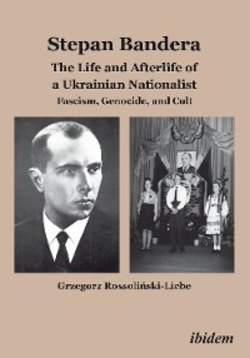Читать книгу Stepan Bandera: The Life and Afterlife of a Ukrainian Fascist - Grzegorz Rossoliński-Liebe - Страница 11
Ukrainian Nationalism and Integral Nationalism
ОглавлениеThe concept of integral nationalism has been attractive to many scholars who have investigated the OUN. The notion of integral nationalism was shaped around 1900 by Charles Maurras, a leader and ideologist of Action Française, a French royalist, conservative, and antidemocratic movement. Fifty years later, John Armstrong published Ukrainian Nationalism, the first comprehensive and authoritative study of the OUN and the Second World War. The American historian classified the extremist form of Ukrainian nationalism as “integral nationalism,” and specified that “the theory and teaching of the Nationalists were very close to Fascism, and in some respects, such as the insistence on ‘racial purity,’ even went beyond the original Fascist doctrines.”[23] According to him, integral nationalism “never had much appeal in France or other Western European countries, but, in modified forms, it became a dominant force in the ‘dissatisfied’ countries of Central and Southern Europe in the twenties.”[24] Before Armstrong, historians such as Carlton Joseph Huntley Hayes applied the concept of integral nationalism to far-right movements and authoritarian regimes in Hungary and Poland, as well as to Fascist Italy and Nazi Germany. This method allowed Hayes and Armstrong to avoid using the contested term “fascism” but it did not contribute to the analytical and comparative understanding of the analyzed movements and regimes. As Armstrong explained, integral nationalism was “by definition a movement of individual nations rather than a universal ideology.”[25]
In his early years as a scholar, Armstrong elaborated a number of important characteristics of the ideology of the Ukrainian nationalists and also a few significant differences and similarities between the OUN and other East Central European far-right movements. He defined “integral nationalism” in terms of five characteristics: “(1) a belief in the nation as the supreme value to which all others must be subordinated, essentially a totalitarian concept; (2) an appeal to mystically conceived ideas of the solidarity of all individuals making up the nation, usually on the assumption that biological characteristics or the irreversible effects of common historical development had welded them into one organic whole; (3) a subordination of rational, analytic thought to the ‘intuitively correct’ emotions; (4) expression of the ‘national will’ through a charismatic leader and an elite nationalist enthusiasts organized in a single party; (5) glorification of action, war, and violence as an expression of the superior biological vitality of the nation.”[26]
Analyzing the ideology of Ukrainian nationalism, Armstrong argued that “the essential irrationalism of the ideology was expressed by fanatical romanticism, which was, however, among the comparatively unsophisticated Ukrainians more spontaneous and genuine than the cynical rejection of reason by the Germans and Italians.”[27] In an article published in 1968 he broadened the scope of his analysis to include other East Central European movements, such as the Hlinka Party and the Croatian Ustaša. He admitted that all of them were influenced by Italian Fascism but emphasized that “at least as a start, it seems preferable to not call OUN’s ideology ‘fascism’ but to designate it ‘integral nationalism.’”[28]
Armstrong rightly analyzed the OUN in the context of the Ustaša, but the classification of the ideologies of the OUN, the Ustaša, and the Hlinka Party as “integral nationalism” is, at least from the contemporary point of view, problematic and not entirely convincing. First, neither did the OUN use the term “integral nationalism,” nor did it identify itself with the ideology of “integral nationalism.” Second, the OUN and its leaders did not claim the “traditional hereditary monarchy” and a number of other features typical of integral nationalism, as did Maurras, the father of this ideology. The OUN was integral in the sense of being exclusive: it anticipated the establishment of an ethnic Ukrainian state without Jews, Poles, Russians, and other minorities. Ukrainian extreme nationalism featured some of the elements of integral nationalism, such as placing the country above all. Similarly, Horthy’s regime in Hungary, Piłsudski’s in Poland, Mussolini’s in Italy, or Hitler’s in Germany were to some extent influenced by Action Française and Maurras’ writings, but they were neither united by, nor were they a form of integral nationalism, as Armstrong and Hayes argued.[29]
If Armstrong’s theoretical approach to the subject was not entirely useful for the contextualization of the OUN, the empirical part of his study—which has significantly influenced later studies of the OUN and UPA—appears today to be truly problematic. Limited access to sources concerning the OUN and UPA, and some of his methods of studying and selecting documents led Armstrong to depict only a part of the history of the movement, while purporting to present the whole. Like many historians at that time, Armstrong had no access to Soviet archives and did not use testimonies and memoirs left by survivors of the OUN and UPA terror. Armstrong based his study mainly on German documents, and on interviews with Ukrainian émigrés who had served in the OUN and UPA. In so doing, he was not able to detect, investigate, and understand many of the atrocities committed by the OUN and UPA during the Second World War. This prevented him from providing an appropriate evaluation of extremist Ukrainian nationalism, affected his understanding of the movement as a whole, and channeled the subsequent study of Ukrainian nationalism into a particular direction.
